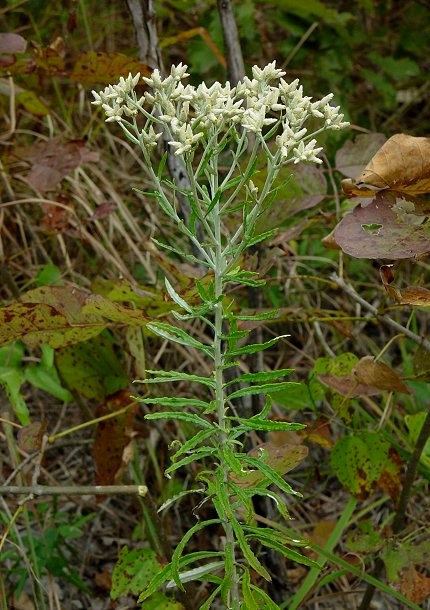Pseudognaphalium obtusifolium (L.) Hilliard & B.L. Burtt
Sweet Everlasting

Native
CC = 2
CW = 5
MOC = 78
© DETenaglia
Pseudognaphalium obtusifolium (L.) Hilliard & B.L. BurttSweet Everlasting | |
 |
Native CC = 2 CW = 5 MOC = 78 |
© DETenaglia |
|
Family - Asteraceae/Gnaphalieae Habit - Taprooted annual or biennial forb, aromatic when bruised or rubbed. Stems - Ascending, to 1 m, typically single from the base but branching upward, moderately to densely woolly, the pubescence sometimes becoming abraded in small patches with age, not appearing glandular, but with sparse glands 0.2-1.0 mm long sometimes present toward the base and hidden under the woolly hairs.
Leaves - Alternate, simple, sessile, usually numerous. Blades 1-10 cm long, linear to narrowly oblanceolate or narrowly lanceolate, the upper surface usually with sparse, stalked glands and sometimes also with sparse, woolly to cobwebby hairs along the midvein, the abaxial surface typically with dense cobwebby pubescence. Lower leaves typically wilted at anthesis. Inflorescences - Broad panicles of flowering heads, often rounded or dome shaped with age. Individual heads usually short-stalked.
Heads - Discoid, the marginal florets pistillate, the central florets perfect. Involucre 5-8 mm long, narrowly ovoid to cup-shaped, the bracts in 5-7 overlapping series, appressed, oblong-lanceolate to lanceolate or ovate, rounded to bluntly or sharply pointed at the tip, the inner few series sometimes irregularly truncate, with dense, woolly hairs toward the base, usually white to straw-colored, rarely faintly pinkish-or purplish-tinged, shiny. Receptacle flat or somewhat convex, naked.
Flowers - Ray flowers absent. Disk flowers minute, creamy white to pale yellow, mostly included within the involucre. Pappus of capillary bristles.
Fruits - Achenes 0.6-0.9 mm long, narrowly oblong-obovoid, slightly flattened, the surface appearing smooth, yellowish brown to greenish brown, sometimes somewhat shiny. Flowering - July - November. Habitat - Upland prairies, forest openings, savannas, glades, tops of bluffs, streambanks, pastures, fields, railroads, roadsides, and open, disturbed areas. Origin - Native to the U.S. Lookalikes - Other species of Pseudognaphalium, which are rare in Missouri. Other info. - This distinctive species is found across Missouri and the eastern half of the continental U.S. and Canada. It is an easy species to identify. The cobwebby to woolly stems and small heads with white involucres are characteristic. Handling the plant will perfume the hands with a distinctive and persistent aroma which somewhat resembles caramel or maple syrup. The plant is common and tolerant of disturbance, and is a source of food for wildlife. It has been used medicinally by numerous native tribes for a wide variety of ailments. Photographs taken in Eminence, MO., 9-21-03 (DETenaglia); also near Labadie, Franklin County, MO, 9-23-2008, and at Caney Mountain Conservation Area, Ozark County, MO, 9-24-2017 (SRTurner). |